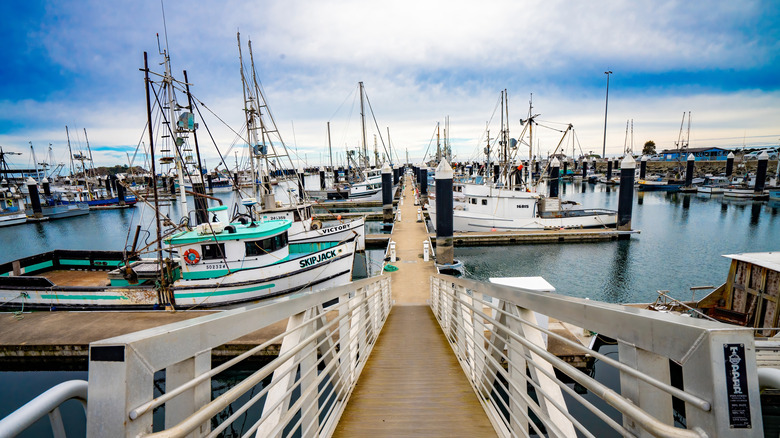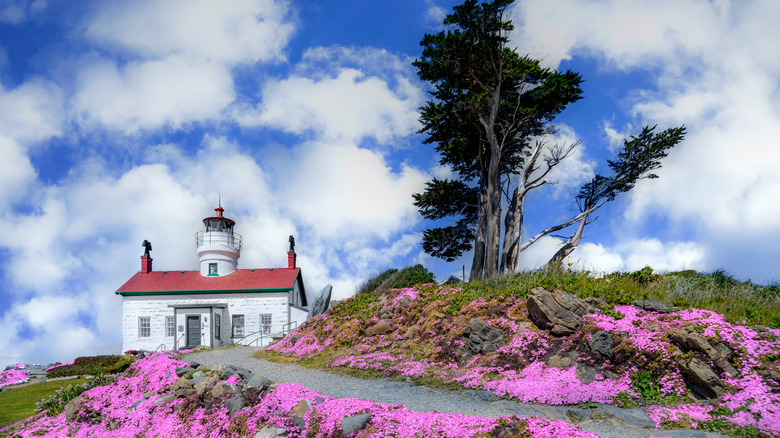The Largest City On California's Redwoods Coast Is A Premier Gateway To Towering Trees And Ocean Charm
California locals agree: Redwood National and State Parks are some of the most incredible spots you need to visit in your lifetime. And if you're headed that way, expect to pass through the "gateway to the Redwoods": Crescent City. Just 25 minutes south of the Oregon state border, this laidback coastal town of 5,500 is considered the last stop along California's stretch of the Pacific Coast Highway.
Imagine misty mornings driving scenic stretches past Pacific Ocean bluffs and afternoons wandering down paths beneath the tallest trees in the world (including this super-secret and exclusive hike with only 50 permits issued per day). Located directly on the border of the Redwoods, Crescent City offers easy access to both of these iconic experiences and so much more.
What to see and do during a stay in Crescent City
The National Park Service has one of its five information centers located in Crescent City itself, and if hiking is on your agenda, be sure to stop there first for a map and a list of suggested trails. Boy Scout Tree Trail in Jedediah Smith Redwoods State Park is one of the most popular options at 5.5 miles roundtrip, but you might also consider easier treks like the half-mile Stout Grove Trail or the single-lane one-hour drive along Howland Hill Road. Deeper into the woods, the Trees of Mystery feature suspension bridges and gondolas up to 1,500 feet in the air that adventure seekers and families will surely love.
High in the sky, you may have a better chance of sighting a bald eagle or spotting the majestic Roosevelt elks that dwell on the forest floor. Return to the coast to witness sea lions playing in the Crescent City Harbor or watch for migrating humpback and orca whales (with the best months for sighting being between May and October).
While there, you might wish to visit Battery Point. Its 19th-century lighthouse, located offshore, is accessible by foot only during low tide and is open to the public. The Cape Cod-style structure is especially photogenic in springtime when the island it sits on becomes blanketed in pink blooms. To the east, the sandy strip of Crescent Beach stretches for miles to the south, offering picnic areas, public bathrooms, the ocean, and a beautiful spot for a stroll at sunset.
How to get there, where to stay, and what to eat
Every stretch of the Pacific Coast Highway is beautiful any time of year (though it is considered one of the best springtime road trips in America). While this is probably the most popular way to reach Crescent City, the town is serviced by Del Norte County Airport (CEC), which offers regional flights from California, Nevada, Arizona, and New Mexico, operated by Advanced Air. There are also Avis and Budget car rentals, which you'll want to make use of (especially if you're coming from out-of-state) unless you plan to fill your schedule with some of the incredible local adventure tours.
Since it's one of the best national parks that's always completely free to enter, you may want to consider staying in the Redwoods themselves. As of this publication, a permit at one of the park's developed campsites costs only $35, and backcountry camping is completely free. In town, you'll find several affordable hotel and B&B offerings for as little as $55 per night, while Airbnb and Hipcamp offer seaside family homes and more unusual options like this treehouse.
In town, you'll find the delectable local food and drink that California's coast is known for. Both SeaQuake Brewing and Port O'Pints offer their own sizeable beer menu, brewed onsite, along with non-alcoholic kombucha (at the former) and root beer (at the latter). The region is also known for wickedly delicious Dungeness crab (seasonal November through July). Either fish for your own on the pier or visit Crescent Seafood for the freshest selection.


